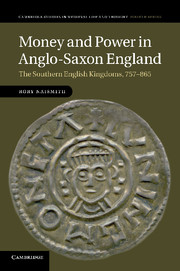Book contents
- Frontmatter
- Contents
- Figures
- Maps
- Tables
- Acknowledgements
- Abbreviations
- Chapter 1 Introduction
- Chapter 2 Money in its political context
- Chapter 3 Looking at coinage: iconography and inscriptions
- Chapter 4 Authority and minting I: the king
- Chapter 5 Authority and minting II: mints, die-cutters and moneyers
- Chapter 6 Value judgements: weight and fineness
- Chapter 7 Production of coinage
- Chapter 8 The circulation of coinage
- Chapter 9 The nature of coin-use in the early Middle Ages
- Chapter 10 Conclusion
- Bibliography
- Index
- References
Chapter 6 - Value judgements: weight and fineness
Published online by Cambridge University Press: 07 October 2011
- Frontmatter
- Contents
- Figures
- Maps
- Tables
- Acknowledgements
- Abbreviations
- Chapter 1 Introduction
- Chapter 2 Money in its political context
- Chapter 3 Looking at coinage: iconography and inscriptions
- Chapter 4 Authority and minting I: the king
- Chapter 5 Authority and minting II: mints, die-cutters and moneyers
- Chapter 6 Value judgements: weight and fineness
- Chapter 7 Production of coinage
- Chapter 8 The circulation of coinage
- Chapter 9 The nature of coin-use in the early Middle Ages
- Chapter 10 Conclusion
- Bibliography
- Index
- References
Summary
Early medieval coinage was fundamentally different from most modern currencies in that its value and acceptability were grounded in its precious-metal content. For this reason the amount of silver or gold in the coinage was usually controlled by the minting authorities and carefully scrutinized by coin-users. There were two factors which determined the quantity of precious metal in a coin: its weight and the purity of the precious metal from which it was struck. These were intimately associated with one another in the early Middle Ages, and together constituted a vital part of the general estimation of the coinage. For Isidore of Seville, weight and fineness – pondus et metallum – were just as important as design (figura) in giving a coin its acceptable status. Standardization and reliability were the underlying concerns and were an important end in themselves for early medieval rulers. Respect for these essential features of the currency was repeatedly demonstrated in early medieval legislation against defective coin. Charlemagne laid down large fines in 794 for anyone who rejected denarii that carried the king’s name and ‘are of sound silver and full weight’ (mero sunt argento, pleniter pensantes); an injunction that was repeated several times in later Carolingian capitularies. Late Anglo-Saxon law-codes made an explicit link between good coinage and the spiritual wellbeing of society as a whole. The ‘maintenance of the coinage’ (feos bot), in the words of the Wulfstanian law-codes V and VI Æthelred and II Cnut, was an integral feature of the ‘maintenance of peace’ (friðes bot), on a par with the performance of military service and the avoidance of sins such as murder, fraud, adultery and sacrilege. As far as one can tell from these documents, reliable coinage was seen as a vital ingredient of a healthy society, and a reliable coinage was one which looked and weighed the part and contained as much silver as it was supposed to.
To understand early medieval coinage in its proper setting, therefore, it is necessary to examine these features of weight and fineness as they metamorphosed over time. Quality and consistency were the primary aims, and by and large both were achieved fairly successfully; hence the generally extensive use of coinage in southern England in this period, even outside its kingdom of origin. But standards could change or slip, reflecting fluctuations in the supply of silver or exploitation of the currency. Who changed standards and why is not always easy to determine, and neither is it always possible to know the economic causes and consequences of such fluctuations, at least on a short-term basis. Yet the matter of how much silver contemporary coinage contained was evidently important to early medieval observers and represented an integral part of its relationship with contemporary society and power.
- Type
- Chapter
- Information
- Money and Power in Anglo-Saxon EnglandThe Southern English Kingdoms, 757–865, pp. 156 - 180Publisher: Cambridge University PressPrint publication year: 2011



